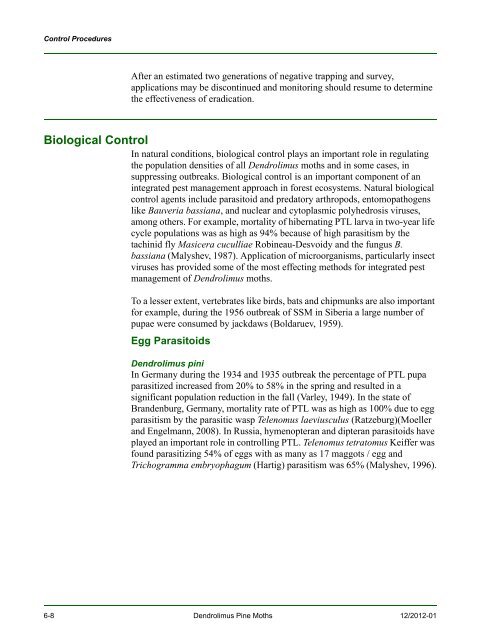New Pest Response Guidelines - aphis - US Department of Agriculture
New Pest Response Guidelines - aphis - US Department of Agriculture
New Pest Response Guidelines - aphis - US Department of Agriculture
Create successful ePaper yourself
Turn your PDF publications into a flip-book with our unique Google optimized e-Paper software.
Control Procedures<br />
After an estimated two generations <strong>of</strong> negative trapping and survey,<br />
applications may be discontinued and monitoring should resume to determine<br />
the effectiveness <strong>of</strong> eradication.<br />
Biological Control<br />
In natural conditions, biological control plays an important role in regulating<br />
the population densities <strong>of</strong> all Dendrolimus moths and in some cases, in<br />
suppressing outbreaks. Biological control is an important component <strong>of</strong> an<br />
integrated pest management approach in forest ecosystems. Natural biological<br />
control agents include parasitoid and predatory arthropods, entomopathogens<br />
like Bauveria bassiana, and nuclear and cytoplasmic polyhedrosis viruses,<br />
among others. For example, mortality <strong>of</strong> hibernating PTL larva in two-year life<br />
cycle populations was as high as 94% because <strong>of</strong> high parasitism by the<br />
tachinid fly Masicera cuculliae Robineau-Desvoidy and the fungus B.<br />
bassiana (Malyshev, 1987). Application <strong>of</strong> microorganisms, particularly insect<br />
viruses has provided some <strong>of</strong> the most effecting methods for integrated pest<br />
management <strong>of</strong> Dendrolimus moths.<br />
To a lesser extent, vertebrates like birds, bats and chipmunks are also important<br />
for example, during the 1956 outbreak <strong>of</strong> SSM in Siberia a large number <strong>of</strong><br />
pupae were consumed by jackdaws (Boldaruev, 1959).<br />
Egg Parasitoids<br />
Dendrolimus pini<br />
In Germany during the 1934 and 1935 outbreak the percentage <strong>of</strong> PTL pupa<br />
parasitized increased from 20% to 58% in the spring and resulted in a<br />
significant population reduction in the fall (Varley, 1949). In the state <strong>of</strong><br />
Brandenburg, Germany, mortality rate <strong>of</strong> PTL was as high as 100% due to egg<br />
parasitism by the parasitic wasp Telenomus laeviusculus (Ratzeburg)(Moeller<br />
and Engelmann, 2008). In Russia, hymenopteran and dipteran parasitoids have<br />
played an important role in controlling PTL. Telenomus tetratomus Keiffer was<br />
found parasitizing 54% <strong>of</strong> eggs with as many as 17 maggots / egg and<br />
Trichogramma embryophagum (Hartig) parasitism was 65% (Malyshev, 1996).<br />
6-8 Dendrolimus Pine Moths 12/2012-01

















